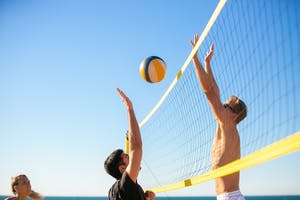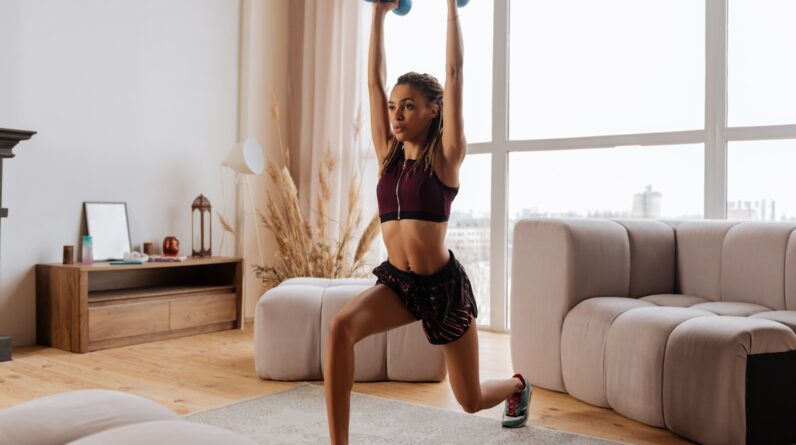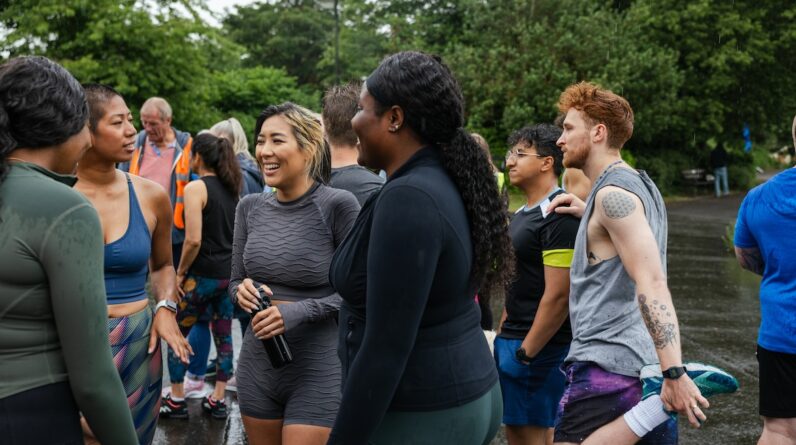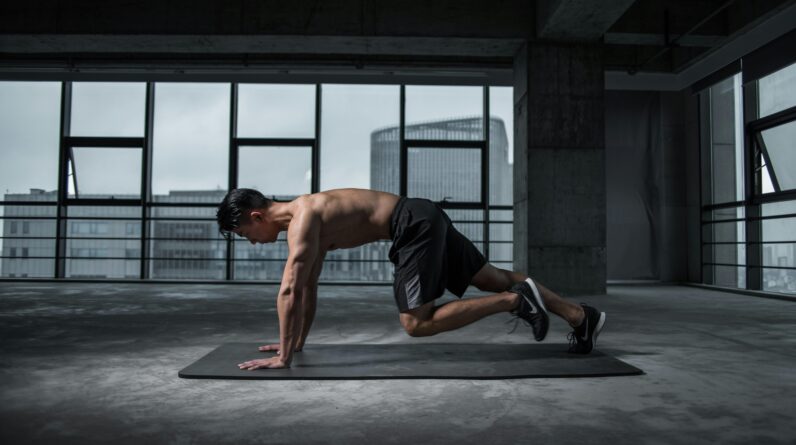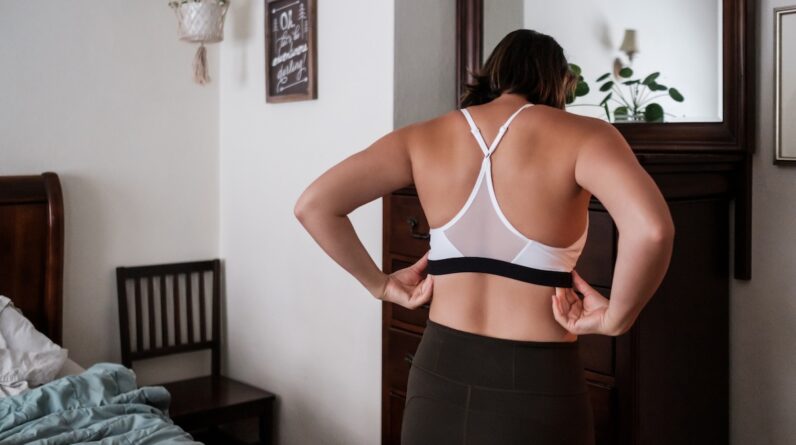
Turns out, my strategy was all wrong. A Lululemon-funded study1 published earlier this year found that wearing a bra with a too-tight underband can actually make it harder to breathe, and thereby harder to work out. In a tight sports bra, the nine subjects—highly-trained female runners—took shallower breaths and more breaths per minute. And that extra work required to breathe took 16 percent more energy.
“When we loosened the underband of the bra, there was a significant reduction in oxygen consumption,” says lead author Shalaya Kipp, a former Olympic steeplechase runner who led the study as part of her PhD in exercise physiology at the University of British Columbia. Most of the runners saw a reduction in oxygen consumption between one to two percent, which might not sound like much, but Dr. Kipp puts it this way: “If a woman was saving two percent in her oxygen cost [during] a three-hour marathon, that could translate up to about a three-minute improvement in the marathon,” she says. “Anyone would love that.”
Although Kipp’s team was studying runners, she believes these findings are relevant for any workout. “It all comes down to: What is the thoracic restriction of that bra on your chest?” she says. “That would cross over to other sports as well.”
Experts In This Article
- Chantelle Murnaghan, PhD, vice president of research and product innovation at Lululemon, doctorate in neuromechanics
- Shalaya Kipp, PhD, exercise physiologist at the University of British Columbia and former Olympic steeplechase runner
The kicker? There wasn’t a professional bra fitter in the lab—the women were all self-selecting too-tight sports bras that were unintentionally making things harder. This isn’t unusual: An older study done in Australia2 found 85 percent of people self-select the wrong sports bra size.
“We’re so used to wanting to get into the smallest size as women that we’ve just trained ourselves to pick products that way.”—Shayla Kipp, PhD
Kipp has a couple of theories about why this is so common. “We’re so used to wanting to get into the smallest size as women that we’ve just trained ourselves to pick products that way,” she says.
Another possible explanation could be that we look at the fit while we’re just standing in a dressing room. “We’re not actually hyperventilating and getting our chest to expand,” Kipp says. That underband might feel fine at rest, but when we’re in motion and breathing hard, it’s a different story.
Another piece of the puzzle might have to do with the fact that working out in a sports bra that’s too loose and unsupportive feels terrible. Insufficient breast support has been found to increase your impact forces3 (how heavily you land on the ground), fatigue your upper body muscles4 faster, decrease your stride length5 when running, and subtly mess with your biomechanics6.
Although this is exactly why you should reach for a high-impact sports bra for any high-impact activity, some of us (like me) sometimes try to squeeze out extra support just by squishing the girls as much as possible.
So, how should a sports bra fit? 6 ways to choose a good one
Since completing her research, Kipp says she’s personally gone up a size when buying new sports bras, and finds she definitely breathes better during workouts. She’s not alone: When British athletes were offered a professional sports bra fitting before the Tokyo Olympics and Paralympics, 17 percent7 of those who wore the prescribed bra said it improved their performance.
Unfortunately, not all of us have access to Olympic-caliber sports bra fitters. But there are some things you can do on your own to make sure you get a good fit.
Figure out where the support is coming from
Before you try on a sports bra, check out the construction. According to Chantelle Murnaghan, PhD, vice president of research and product innovation at Lululemon, there are three kinds of sports bras: those that use compression to provide support (by simply pressing the tissue toward the chest), those that encapsulate each breast individually in its own cup, and those that combine both strategies.
“The right level of support can be achieved in any of those ways,” she says. However, if you feel like the compression needed to keep your breasts in check squeezes your ribcage too much, look for a bra that uses encapsulation—this style can be particularly helpful for bigger cup sizes.
Slip your fingers under the underband
If you’re trying a hook-and-eye bra that attaches at the back or one that zips up in the front, Murnaghan suggests making sure you can slip a couple of fingers underneath the band once you have it on. Then, pull it away from your body—it shouldn’t move more than an inch or so, or else you won’t get the support you need.
If it’s a sports bra that you pull on overhead, the underband will be more flexible (because you need to get it over your shoulders); just make sure it recoils enough once it’s on that it gives the bra a strong foundation, but you can still easily slip your fingers underneath.
Look at how you fill the cups
A good-fitting sports bra will reduce the movement of the breast tissue from every angle. To do that, it needs to lie flat against your skin, and cover the full breast without creating a double boob situation. “Make sure that you’re not spilling over the top, but also that you don’t have extra space—find that ‘Goldilocks’ in the cups,” Murnaghan says.
Pay attention to the straps
Exactly where the straps lie might vary between you and your training buddy. “We all have different slopes of our shoulders. We have different widths of our shoulders,” Murnaghan says. Just watch that they don’t sit so close to the neck that they dig into your skin, or so far out on the shoulders that they fall off when you bend to the side. This might mean you need to reach for a racerback style instead of straight straps, or vice versa.
Consider the feel
A sports bra is something you’re going to be wearing when you’re working your hardest, so you want it to be comfortable. In addition to the fit, Murnaghan also suggests paying attention to how it feels. Is the pressure distributed evenly or poking you in any one area? Is the material on the edges soft enough to keep your skin from chafing?
Jump around (or hop on a treadmill)
If everything looks good in front of the mirror and feels good when you’re just standing there, it’s time to put it to the test. “Start jumping around and kind of get an idea of how that feels,” Kipp suggests. If there’s a treadmill in the store, go for a short jog just like you would with running shoes. “It might feel silly,” Kipp says, “but it might really make a big difference when you’re out exercising.”
Well+Good articles reference scientific, reliable, recent, robust studies to back up the information we share. You can trust us along your wellness journey.
- Kipp, Shalaya et al. “Sports Bra Restriction on Respiratory Mechanics during Exercise.” Medicine and science in sports and exercise vol. 56,6 (2024): 1168-1176. doi:10.1249/MSS.0000000000003403
- McGhee, Deirdre E, and Julie R Steele. “Optimising breast support in female patients through correct bra fit. A cross-sectional study.” Journal of science and medicine in sport vol. 13,6 (2010): 568-72. doi:10.1016/j.jsams.2010.03.003
- White, J. L., Scurr, J. C., & Smith, N. A. (2009). The effect of breast support on kinetics during overground running performance. Ergonomics, 52(4), 492–498. https://doi.org/10.1080/00140130802707907
- Milligan, Alexandra et al. “The effect of breast support on upper body muscle activity during 5 km treadmill running.” Human movement science vol. 38 (2014): 74-83. doi:10.1016/j.humov.2014.06.001
- White, J., Wakefield-Scurr, J., & Mills, C. (2013). Breast support implications for female recreational athletes during steady-state running. Abstract from 31st International Conference on Biomechanics in Sport, Taipei, Taiwan, Province of China. https://ojs.ub.uni-konstanz.de/cpa/article/view/5600
- Powell, Douglas W et al. “Increasing breast support is associated with altered knee joint stiffness and contributing knee joint biomechanics during treadmill running.” Frontiers in sports and active living vol. 5 1113952. 21 Apr. 2023, doi:10.3389/fspor.2023.1113952
- Wakefield-Scurr, J., Sanchez, A., Jones, M., Hockley, L., Biswas, A., Johnson, F., & Roberts, E. (2022). A multi-phase intervention study of sports bra prescription for elite UK female athletes preparing for the Tokyo Olympics and Paralympics. Research in Sports Medicine, 32(1), 186–200. https://doi.org/10.1080/15438627.2022.2090254


